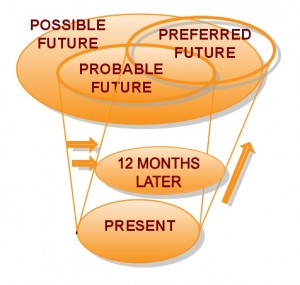Choosing What Not to Do
 If you’ve been in on very much of this conversation, you are probably becoming very familiar with this diagram. I use it for all kinds of discussions (you’ll see many of them right here), but I’m not sure we’ve ever talked about choosing what not to do.
If you’ve been in on very much of this conversation, you are probably becoming very familiar with this diagram. I use it for all kinds of discussions (you’ll see many of them right here), but I’m not sure we’ve ever talked about choosing what not to do.
Choosing what not to do is very near the heart of identifying your preferred future. If you study the diagram for a moment, you’ll see that the preferred future is actually a subset of three areas:
- The Probable Future: I think of this as a way of describing the way things will be in your ministry or organization if nothing changes. You pick the timeline, 5 years, 10 years, 20 years, it doesn’t matter. The probable future is what things will look like if you’re doing the same things. See also, Start with the End in Mind.
- The Possible Future: This is actually all of the known or imagined possibilities for the future. For example, you might have a meeting where you brainstorm as many possibilities for connecting people as you can. See also, Where Do You Want to Go with Your Small Group Ministry?
- The Adjacent Possible: This section isn’t labeled in the diagram, but if you look closely in the preferred future section, you’ll notice that it includes some of what is actually beyond the possible future. See that? The white space. I think of the adjacent possible as the Ephesians 3:20-21 aspect of the preferred future. See also, Grouplife Agnostics and the Adjacent Possible.
Where does choosing what not to do come in? According to Michael Porter, “choosing what not to do is the essence of strategy.” Porter, often recognized as the father of modern strategy, has boiled down our discussion to its essence.
Calling out the preferred future is really a three step process:
- identifying the gold of what you are currently doing
- imagining all of the possibilities beyond what you are currently doing
- choosing what not to do trims out the extra that may very well be good but not great.
What do you think? Have a question? Want to argue? You can click here to jump into the conversation.

